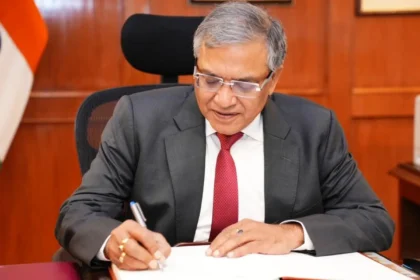From Padyatra to PowerPoint: How Jan Suraaj Mirrors a Political Startup More Than a Traditional Party
There was a time when Prashant Kishor could change the course of elections without ever taking the stage. His political strategies could swing states, tilt narratives, and rewire the electoral grammar of a campaign. But when the man behind the machine steps out in front, when the strategist decides to become the face, the game shifts. And so does the ground beneath his feet.
I’ve witnessed two political yatras up close. One was former Andhra Pradesh Chief Minister Jagan Mohan Reddy’s Praja Sankalpa Yatra – a charged, almost cinematic political movement that swept through Andhra Pradesh like a storm.
It had energy, discipline, and a clear destination. The other is Prashant Kishor’s (popularly known as PK in the political milieu) Jan Suraaj Yatra in Bihar, which, honestly, feels more like a startup demo trying to pitch new politics in a place that still values old relationships.
Jagan’s yatra was textbook campaign management. Every interaction was part of a designed arc – from the drone shots to the voter whispers; everything was tracked, tested, and tactically deployed. And behind it all was PK and his at team at Indian Political Action Committee (I-PAC) – operating dashboards, crunching feedback, refining the message. It felt like the state was synced to a strategy document.
Why the public remains cautious about Jan Suraaj
Now, cut to Bihar. Here, PK is no longer behind the scenes; he is at the front of the rally, holding the mic, shaking his hands, delivering the message himself. He’s walked over 3,500 kilometres across scorching highways and sleepy villages, from the foothills of Champaran to the alleys of Gaya. He has spoken to countless people, looked them in the eye, asked questions, and listened. And yet, something hasn’t clicked. There’s a distance that no number of steps seems to have bridged.
This is the same man who played a pivotal role in helping leaders such as Narendra Modi, Jagan, Mamata Banerjee, Nitish Kumar, Arvind Kejriwal, and M.K. Stalin, leaders who brought with them a towering presence, loyal cadres, strong booth networks, and decades of political capital. PK brought clarity, campaign discipline, and sharp positioning. But he was never asked to be the soul of the movement, just the mind behind it.
In Bihar, he doesn’t have that luxury.
Here, he is not just the strategist. He is the leader, the face, the organiser, the symbol. And that’s where the paradox begins. Because while he is overflowing with plans, data sets, PowerPoint decks, dashboards, and policy roadmaps, he is still missing something basic: a party people can lean on. A structure that outlasts the speech. A second line of leadership that keeps the momentum going. A booth-level army that can turn nods into votes.
It’s like trying to launch a rocket with only the blueprint, no launchpad, no ground crew, and no fuel.
To be clear, there’s nothing hollow about his intent. PK speaks of governance, better schools, smarter agriculture, and youth-driven politics, things that matter. But Bihar doesn’t just run on ideas. It runs on samajik samikaran, bhoj aur bhaichara – local trust, familiar faces, and a certain emotional muscle. People want to believe not just in a plan, but in the person who will fight for it, day in and day out, with or without a camera.
Today, Jan Suraaj has all the symptoms of sincerity, and yet, the public remains cautious. Interested, yes. Impressed, maybe. But committed? Not quite. Bihar is watching. It is smiling, occasionally nodding, but it hasn’t yet walked behind him.
Recently, I travelled through parts of Bihar including Darbhanga, Muzaffarpur, and Champaran, to see what Prashant Kishor’s over 3,500-kilometre padyatra has really achieved. This is no ordinary walk. No political leader in recent memory has covered Bihar like this, carrying not just slogans but also vision documents, detailed action plans for each constituency, and even a full governance model. It felt less like a political rally and more like a consultancy presentation full of bullet points and deadlines.
But the reality on the ground is more complex.
Everywhere I went, from roadside tea shops to local gatherings, people spoke well of him. His thoughts on education, healthcare, governance, and involving the youth were respected by people across castes and backgrounds. Even some seasoned journalists had good things to say. But then came a pause, a shrug, and a common question: He is good, but how will he win?
There’s a lot of interest in him, no doubt. But strong support? That’s still not clear. What’s more worrying for Jan Suraaj is that most people couldn’t name a single other leader from the group. A common question was that who else is there in the party besides PK? Being the face of a movement is one thing. Being the only face, that’s a problem.
PK has the GPS but no vehicle
Still, even if PK doesn’t turn this padyatra into a political win, he has definitely created a civic impact. In a state where politics has mostly been about caste and the status quo, he has made people think about real issues. That may not bring votes right now, but it definitely counts for something.
In Bihar, politics doesn’t run on manifestos, it runs on jaat, paat aur jamat. Every party has its caste engine well-oiled. The Rashtriya Janata Dal (RJD) has the Yadav-Muslim formula, Janata Dal (United) (JD (U)) banks on Kurmis and extremely backward classes (EBCs), Bharatiya Janata Party (BJP) keeps its upper-caste base intact, Lok Janshakti Party (LJP) has the Paswan vote, and Hindustani Awam Morcha (HAM) counts on Dalits with Jitan Ram Manjhi’s name. These aren’t alliances, they’re default settings. Voters don’t need a reason; they need a relation.
Then comes Jan Suraaj, with no caste base, no loyal voter blocks, no ready-made apne log. PK is trying to float an idea-driven, development-focused platform in a state where caste is still the first filter for political choice. You can walk thousands kilometres with good intent, but without a caste network or booth-level jugad, even the best ideas struggle to stick.
While others campaign saying, “Main aapka neta hoon (I am your leader),” PK says, “Main aapka vikalp hoon (I am your alternative).” It sounds noble, and maybe it is, but Bihar’s politics still demands the old-school biradari ki guarantee.
Jan Suraaj may be trying to build a new expressway, but Bihar’s voter is still stuck in the bylanes of identity. PK has the GPS. The problem is, there’s no vehicle yet.
During my conversations, the topic of the leadership vacuum in Jan Suraaj kept coming up, especially when it comes to Dalit representation. Yes, the party has Manoj Bharti, a former diplomat, and Prashant Kishor was quite proud to announce that Jan Suraaj’s first working president is a Dalit. Great optics. But let’s be honest, does Manoj Bharti have any mass connect? Not really. He may have years of experience in diplomacy, but in Bihar’s gritty political scene, he’s still a newcomer. Here, Dalit leaders like the late Ram Vilas Paswan or Jitan Ram Manjhi didn’t emerge from Lutyens’ drawing rooms; they rose from the streets, lived among their people, and earned their trust over decades.
That’s how they became icons. Jan Suraaj, on the other hand, seems to have skipped that part.
Then there is the matter of the party’s first national president, Uday Singh, a former BJP MP. Now here is where it gets interesting. Prashant Kishor has spent years attacking Tejashwi Yadav over his lack of education. But guess what? According to his affidavit, Uday Singh himself is just a 12th pass. Apparently, when it comes to his own team, the education bar suddenly gets flexible.
In a recent press conference, PK claimed Jan Suraaj has a pool of leaders with unmatched capabilities. Really? Who exactly? RCP Singh, a former Rajya Sabha MP, and Uday Singh, a former Lok Sabha MP. Let me tell you, this unmatched pool is mostly made up of leaders who are either well into retirement age or who haven’t won an election in years. If this is Jan Suraaj’s talent bench, the match hasn’t even started and the crowd’s already left the stadium.
Bihari voters were hoping for a neta who could lead from the front. What they got instead was a lecture series and an Excel sheet. As one shopkeeper in Darbhanga joked, “Humko leader chahiye tha, PK to narrative le aaya (We wanted a leader, but PK showed up with a narrative).” Inspiring speeches and PowerPoint plans may win applause at think-tank events, but on Bihar’s dusty campaign trails, voters are still waiting for someone who can actually win a booth not just a debate.
And let’s not forget PK had earlier promised that Jan Suraaj’s first national president would be from the Dalit community. But Uday Singh is a Rajput. So naturally, people in Bihar are asking: “Bas bolne ke liye tha kya? (Was it just hollow rhetoric?).”
Jan Suraaj is neatly designed, but without ground-level connectors
Add to that, there’s no visible Muslim face either. Unlike RJD or JDU, which have a whole ecosystem of caste-based local leaders who know how to rally their communities, Jan Suraaj still looks like a top-down PowerPoint project, neatly designed, but missing ground-level connectors.
Right now, one debate fits Jan Suraaj perfectly: is it a political party or just a very passionate pressure group?
If you closely listen to Prashant Kishor’s speeches, whether in Darbhanga, Purnia or Madhubani etc, he talks about everything from labour migration and unemployment to fixing schools and hospitals. All very important issues, no doubt. But the tone, the structure, even the setup, it feels more like someone running a policy awareness campaign than a political movement.
Jan Suraaj has everything that a good pressure group needs: thousands of full-time workers, real-time data from the field, and sharp feedback loops. But here’s the problem: political parties don’t win elections by just collecting data. They win through local functionaries who know how to convert that data into action at the booth level. Ground intelligence is great on a dashboard, but it doesn’t turn into votes unless someone is there to act on it.
So, PK has to make a choice: does he want to fix the system from the outside, or contest it from the inside? Because right now, he’s sounding more like a reformer than a neta.
At some point, Prashant Kishor will have to step out of his strategy lab, shut down the PowerPoint, and start thinking like a politician. Because in Bihar, politics isn’t just about data. It’s about dosti, dharna, and dependable cadre.
Also Read: IND vs ENG 1st Test Day 3: Jasprit Bumrah’s 5-Wicket Haul Sets Up Thrilling Photo-Finish – In Pics








